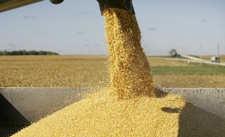redo Jump to...
print Print...
Note: This article is from The BBC (British Broadcasting Corporation).

Corn is unloaded into a grain trailer during harvest; nearly 40% of U.S. production goes towards ethanol production for fuel.
(by James Melik, BBC World News) – The head of the world’s largest food producer believes high prices are due to the growing of crops for biofuels.
“The time of cheap food prices is over,” says Nestle chairman Peter Brabeck-Letmathe.
He is highly critical of the rise in the production of bio-diesel, saying this puts pressure on food supplies by using land and water that would otherwise be used to grow crops for human or animal consumption.
“If no food was used for fuel, the prices would come down again – that is very clear,” he says.
“We are now in a new world with a completely different level of food prices because of the direct link with fuel,” he says.
He says biofuels are only affordable because of the high subsidies they receive, particularly in the U.S. “It is absolutely unacceptable and cannot be justified,” he says. “There is one demand that I have, and that is not to use food for fuel.”
Water crisis
 Mr. Brabeck-Letmathe says politicians have not understood that the food market and the oil market are the same – they are both calorific markets.
Mr. Brabeck-Letmathe says politicians have not understood that the food market and the oil market are the same – they are both calorific markets.
“The only difference is that with the food market you need 2,500 calories per person per day, whereas in the energy market you need 50,000 calories per person,” he says.
When politicians said they wanted to replace 20% of fossil fuels with biofuels, it meant increasing the production of crops threefold, according to Mr Brabeck-Letmathe. Most of the world’s sugar production now goes into making biofuels, he says.
Agriculture uses 70% of world’s water consumption and the public must be made aware of the inefficient usage of this precious resource, Mr Brabeck-Letmathe adds. “It takes about 4,600 litres of water to produce one litre of pure ethanol if it comes from sugar, and it takes 1,900 litres of water if it comes from palm oil,” he says.
“This is not a crisis which might arise in 100 years, it is something which is already here today.”
……………….
Reprinted here for educational purposes only. Originally published on July 17, 2012. May not be reproduced on other websites without permission from the BBC.
Questions
Background
Nestlé : Nestle is a Swiss multinational company headquartered in Switzerland.
- It is the largest food company in the world measured by revenues. It was listed as the world’s most profitable corporation in 2011.
- Nestlé’s products include baby food, bottled water, breakfast cereals, coffee, confectionery, dairy products, ice cream, pet foods and snacks.
- Nestlé has around 450 factories, operates in 86 countries, and employs around 328,000 people. (from wikipedia)
The following information is from The Institute for Energy Research report “Hard Facts: An Energy Primer” PDF document, pages 49-51 (instituteforenergyresearch.org/hardfacts.pdf), or visit the website and scroll down for link to PDF: instituteforenergyresearch.org/hardfacts
- Biomass, including ethanol, produces 4.5 percent of the total energy consumed in the United States.
- Replacing U.S. gasoline consumption with corn ethanol would require planting 500 million acres with only corn—more than the current total U.S. cropland.
- Biomass represents 1.4 percent of U.S. electricity generation.
- Congress mandated the production of 100 million gallons of cellulosic ethanol in 2010, but not a drop of cellulosic ethanol was commercially blended with gasoline in 2010.
Daily “Answers” emails are provided for Daily News Articles, Tuesday’s World Events and Friday’s News Quiz.



